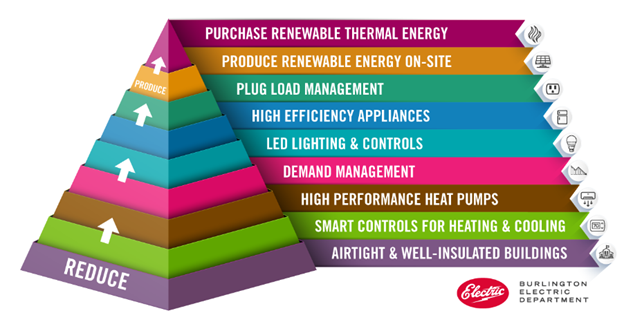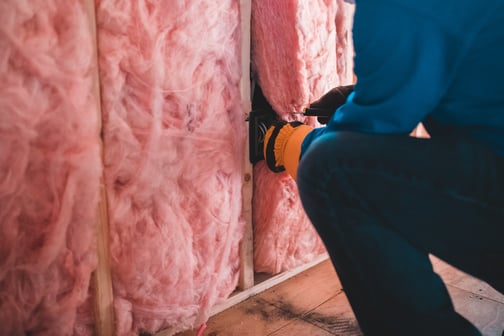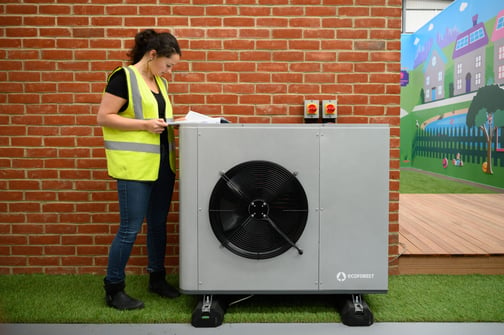Over the last few years, climate action has become a central focus for governments, and the business case for doing something about climate change has become clearer than ever before. With this shift, “Net Zero by 2050” is a term that seems to get thrown around by organizations, businesses, and municipalities alike. But what does it mean, and how do we get there?
Defining Net Zero
Net zero has different definitions based on what is being discussed. At the municipal level, Burlington, VT describes its net zero goal as “to reduce and eventually eliminate fossil fuel usage in heating and ground transportation.” Still others are focused on net zero carbon goals, which opens a whole can of worms around fuel sources like cord wood or wood pellets. In this blog post, we are going to focus on the narrower definition of net zero energy (NZE) buildings the U.S. Department of Energy defines as “a building [that] produces enough renewable energy to meet its own annual energy consumption requirements, thereby reducing the use of nonrenewable energy in the building sector.” Not every building will be able to hit that NZE target, but there is opportunity for existing buildings to strive for lofty goals in order to make a significant impact on their building emissions.
The Net Zero Energy Pyramid
The Burlington Electric Department (BED) created a Net Zero Energy Buildings Pyramid to help building owners focus on the various steps they can take to meet NZE goals. As the district engineer for the Burlington 2030 District, one of the goals of which is to reduce building energy use consumption 50% by 2030, I often use BED’s NZE Buildings Pyramid when providing custom property energy plans to Burlington 2030 District property owner members as a way to help owners visualize the actionable steps to nudge their building closer to NZE. The pyramid (shown below) is split into two sections: Reduce and Produce. It is configured such that a building owner should start at the bottom layer and work upwards, as the lower layers have a higher impact on energy use and can increase the impacts of the layers above.
 The biggest takeaway from the pyramid is to reduce BEFORE adding renewables. When working with clients that have meaningful carbon emissions reduction related goals, their first instinct is often to add renewable energy (we’re always hearing “well we definitely want to add solar panels!”). While there’s certainly nothing wrong with adding renewable energy production to a building, the renewable energy produced will not make a dent in a building’s emissions if the building is using a ton of energy to begin with (not to mention that creating renewable electricity won’t help reduce emissions related to heating with fossil fuels!). So how can a building owner reduce consumption, and which projects will make the biggest dents?
The biggest takeaway from the pyramid is to reduce BEFORE adding renewables. When working with clients that have meaningful carbon emissions reduction related goals, their first instinct is often to add renewable energy (we’re always hearing “well we definitely want to add solar panels!”). While there’s certainly nothing wrong with adding renewable energy production to a building, the renewable energy produced will not make a dent in a building’s emissions if the building is using a ton of energy to begin with (not to mention that creating renewable electricity won’t help reduce emissions related to heating with fossil fuels!). So how can a building owner reduce consumption, and which projects will make the biggest dents?
Sealing the Envelope (no licking involved!)
The bottom of the pyramid indicates “airtight and well-insulated buildings.” This is referring to the need to reduce heating and cooling losses through the building’s walls, floors, and roof, which make up what is termed in the building science world as the “envelope.” By reducing these losses, less energy is needed to heat and cool the building throughout the year and may mean that when sizing new heating/cooling equipment, smaller equipment that uses less energy (and costs less!) may be able to effectively condition the building. The envelope measures that have significant impacts across most existing buildings are improving the “R-value” of the building’s insulation (i.e., more effective insulation in the right places) and sealing leaks. This is often referred to as building “weatherization” and depending on where you are located/which utilities you have, there may be incentives or support programs available to cost-share or pay for a thermal envelope assessment. Where carbon emission reductions are a priority, make sure to discuss alternates to high global warming potential (GWP) spray foams for insulation with your contractor.
 One important note that is not addressed in the NZE Buildings Pyramid is that as the building envelope is made more airtight, mechanical ventilation is needed to provide adequate fresh air to occupants (in a building with a leaky envelope, fresh air often just infiltrates through the envelope). While mechanical ventilation will add some energy use, it is important to keep air quality in buildings at healthy levels for occupants. Installing Energy Recovery Ventilators (ERVs) will provide ventilation but minimize energy usage by transferring heat between outgoing and incoming air streams.
One important note that is not addressed in the NZE Buildings Pyramid is that as the building envelope is made more airtight, mechanical ventilation is needed to provide adequate fresh air to occupants (in a building with a leaky envelope, fresh air often just infiltrates through the envelope). While mechanical ventilation will add some energy use, it is important to keep air quality in buildings at healthy levels for occupants. Installing Energy Recovery Ventilators (ERVs) will provide ventilation but minimize energy usage by transferring heat between outgoing and incoming air streams.
Control…Not Just for Diets
The second tier of the pyramid, “smart controls for heating and cooling equipment,” is referring to making informed decisions about how best to control your building’s heating and cooling equipment. The strategies for building control vary from building to building based on equipment types, system interconnectivity, flexibility of controls, and use patterns of the building.
Here are some common smart control items to consider implementing at your building:
- Make sure there is not simultaneous heating and cooling. On the surface, this sounds very obvious, but we see this happening all the time. If you have both heat pumps and a boiler loop serving terminal heating equipment in your building, make sure that the boiler loop is not heating the space while the heat pump is in cooling mode. This may require programming changes, setpoint adjustments, or manual control if your building does not have a building automation system.
- Add occupancy schedules and temperature setbacks. When a building is not occupied, there is no reason to heat and cool it to the temperatures comfortable for occupants. If your building does not already have them, consider installing smart thermostats. These allow for easy programming of schedules and temperature setbacks and are especially helpful if you have multiple tenant spaces with different occupancy schedules. They can also be Wi-Fi connected to allow for changes to be made remotely. If your air handling unit has a scheduling capability, use it! Similar to temperature, ventilation can be set back during unoccupied times.
- If you have a building automation system, there are even more opportunities to reduce energy usage through smart controls. There have been huge strides in control strategies over the last 10 years. Work with an energy consultant (like us!) to identify low and no-cost opportunities for improving controls in your building.
(Heat) Pump it Up!
Heat pump technology has made huge strides in the last 5-10 years in being able to operate successfully (when designed and installed correctly) in cold climates. There are many heat pump options available. Ducted and ductless air source heat pumps have become relatively common place and are a great option in many applications to electrify heating and add cooling. Other options include centralized air-to-water heat pumps, which can be used to provide heating that feels more similar to a classic boiler system by providing hot water to terminal units (including my favorite cozy heating type…radiant floors). Ground source heat pumps use energy in the ground or water table to heat and cool your building. This is a more expensive, but extremely efficient option (also very dependent on where your building is located).

Heat pumps do not work well if you have a leaky building envelope, which is one of the reasons envelope improvements are on the bottom of the pyramid, so make sure to focus first on envelope improvements before looking into heat pump technology. Heat pumps won’t work for all parts of all buildings, especially if there are constraints of the original building construction preventing the envelope from being updated and improved. However, they are an important part of our current toolkit for building electrification as a whole and should be investigated as an option at the very least.
Also, if carbon emissions reductions are part of your goals, tell your designer or contractor that you want to use heat pumps with low GWP refrigerants – these are becoming increasingly available in the Northeast.
DEMAND Demand Management
When we talk about “demand” we are talking about peak demand, or the highest instantaneous electric usage of a building or electric grid. For electric utilities, there are certain periods where there is the highest electric draw, and therefore electric costs the most (think supply & demand). Electric utilities want to decrease their peak demand because it makes electricity cost less, and ideally these savings are passed on to their customers. In addition to costing less, higher peak demand increases the chances that a utility has to purchase electricity associated with non-renewable sources.
So why does this matter to building owners? Two reasons – first, many utilities include a peak demand charge on your bill, so reducing the instantaneous electric draw will provide you cost savings. This is related to YOUR BUILDING’S peak, which may or may not overlap with the grid peak, and your utility may look at your building’s usage during just the grid peak, or at your building’s overall peak in determining the peak demand charge. So, it’s helpful to you from a cost perspective to reduce instantaneous use. In addition to reducing energy use overall, also consider “spreading the love” in terms of your electric loads – set up controls or protocols so that high energy processes don’t all happen simultaneously.
Second reason - reducing your building’s strain on the electric grid during electric grid peak periods is the right thing to do. As more buildings electrify (as they must to meet these NZE goals!) electric utilities have a big task ahead to fortify and expand their grid capacity. Why not do your part to help your community as a whole be able to successfully electrify? From this perspective, analyze your usage trends and adjust timing of electric-using activities. Consider options like load-switching or installing battery storage. Perhaps you don’t allow use of your EV chargers during peak grid periods, or your pre-heat or pre-cool your building during non-peak periods when you know it will be a particularly hot or cold day. Some utilities have a demand response program that will notify you ahead of time when there will be a “peak event,” which is when electric use is expected to exceed typical usage for a certain period of time. In Burlington, this tends to happen a few times each summer during the afternoons on very hot and humid summer days (though as heating becomes more electrified it will likely start to happen on very cold winter days as well). During these periods, it’s recommended to adjust temperature setpoints and just deal with being slightly warmer (in the summer) or cooler (in the winter) for those few hours than on a normal day and avoiding electric intensive activities like EV charging, running a washing machine/dryer, etc.
Next week: I’ll tackle the top half of the NZE Pyramid, including lighting, efficient appliances, and renewables! Stay tuned!


